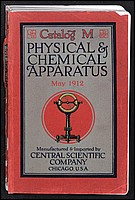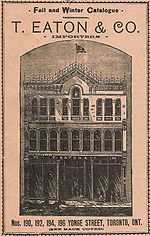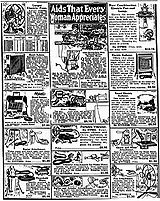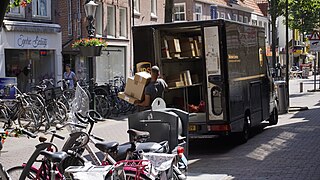
Package delivery or parcel delivery is the delivery of shipping containers, parcels, or high value mail as single shipments. The service is provided by most postal systems, express mail, private courier companies, and less than truckload shipping carriers.

A department store is a retail establishment offering a wide range of consumer goods in different areas of the store, each area ("department") specializing in a product category. In modern major cities, the department store made a dramatic appearance in the middle of the 19th century, and permanently reshaped shopping habits, and the definition of service and luxury. Similar developments were under way in London, in Paris and in New York (Stewart's).

Sears, Roebuck and Co., commonly known as Sears, is an American chain of department stores founded in 1892 by Richard Warren Sears and Alvah Curtis Roebuck and reincorporated in 1906 by Richard Sears and Julius Rosenwald, with what began as a mail ordering catalog company migrating to opening retail locations in 1925, the first in Chicago. In 2005, the company was bought by the management of the American big box discount chain Kmart, which upon completion of the merger, formed Sears Holdings. Through the 1980s, Sears was the largest retailer in the United States. In 2018, it was the 31st-largest. After several years of declining sales, Sears's parent company filed for Chapter 11 bankruptcy on October 15, 2018. It announced on January 16, 2019, that it had won its bankruptcy auction, and that a reduced number of 425 stores would remain open, including 223 Sears stores.

Penney OpCo LLC, doing business as JCPenney and often abbreviated JCP, is an American department store chain that operates 664 stores across 49 U.S. states and Puerto Rico. Departments inside JCPenney stores include Men's, Women's, Boys', Girls', Baby, Bedding, Home, Fine Jewelry, Shoes, Lingerie, JCPenney Salon, JCPenney Beauty, as well as leased departments such as Seattle's Best Coffee, US Vision optical centers, and Lifetouch portrait studios.

Direct marketing is a form of communicating an offer, where organizations communicate directly to a pre-selected customer and supply a method for a direct response. Among practitioners, it is also known as direct response marketing. By contrast, advertising is of a mass-message nature.
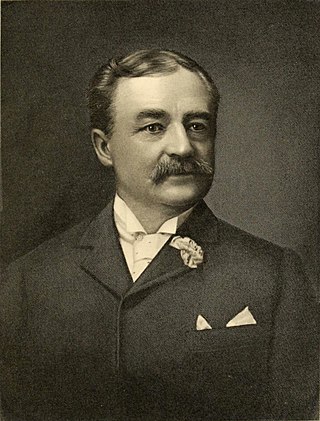
Aaron Montgomery Ward was an American entrepreneur based in Chicago who made his fortune through the use of mail order for retail sales of general merchandise to rural customers. In 1872 he founded Montgomery Ward & Company, which became nationally known.

Montgomery Ward is the name of two successive U.S. retail corporations. The original Montgomery Ward & Co. was a world-pioneering mail-order business and later a leading department store chain that operated between 1872 and 2001. The current Montgomery Ward Inc. is a national online shopping and mail-order catalog retailer that started several years after the original Montgomery Ward shut down.

The Very Group Limited is a multi-brand online retailer and financial services provider in the United Kingdom and Ireland. Its head offices are based in the Speke area of the city of Liverpool, England. The brand was established in November 2005 as a result of the merger of the former Littlewoods and Shop Direct companies, the retailer was known as Littlewoods Shop Direct Group until a corporate rebranding to Shop Direct Group in May 2008. In 2013, the company rebranded to Shop Direct, dropping the 'group' from its name. Shop Direct rebranded themselves to The Very Group in 2020.

GUS plc was a FTSE 100 retailing, manufacturing and financial conglomerate based in the United Kingdom. GUS was an abbreviation of Great Universal Stores, the company's name before 2001, while it was also known as the Glorious Gussies amongst stockbrokers. The company started out as Universal Stores, a mail order business created by the Rose family. In 1931, Isaac Wolfson joined the mail order company and would, through a series of takeovers, turn it into a retail, manufacturing and financial conglomerate, becoming Europe's biggest mail order firm and with over 2,700 physical stores. His son, Leonard Wolfson, followed him as chairman, to be succeeded by his nephews David Wolfson (1996–2000) and Victor Barnett (2000–2002). During the 1980s, the business divested much of its physical retail and manufacturing subsidiaries under Leonard Wolfson to concentrate on mail order, property and finance. In October 2006, the company was split into two separate companies: Experian which continues to exist, and Home Retail Group which was bought by Sainsbury's in 2016.

Sir Pryce Pryce-Jones was a Welsh entrepreneur who formed the first mail order business, revolutionising how products were sold. Creating the first mail order catalogues in 1861 – which consisted of woollen goods – for the first time customers could order by post, and the goods were delivered by railway. The BBC summed up his legacy as "The mail order pioneer who started a billion-pound industry".

Spiegel was an American direct marketing retailer founded in 1865 by Joseph Spiegel. Spiegel published a catalog, like its competitors Sears and Montgomery Ward, which advertised various brands of apparel, accessories, and footwear, as well as housewares, toys, tools, firearms, and electronics. Their company brands included Newport News, Shape FX, and Old Kraftsman, among others. They also operated brick-and-mortar stores.
A catalog merchant is a form of retailing. The typical merchant sells a wide variety of household and personal products, with many emphasizing jewelry. Unlike a self-serve retail store, most of the items are not displayed; customers select the products from printed catalogs in the store and fill out an order form. The order is brought to the sales counter, where a clerk retrieves the items from the warehouse area to a payment and checkout station.
Loyalty marketing is a marketing strategy in which a company focuses on growing and retaining existing customers through incentives. Branding, product marketing, and loyalty marketing all form part of the customer proposition – the subjective assessment by the customer of whether to purchase a brand or not based on the integrated combination of the value they receive from each of these marketing disciplines.
Greengate Centre is an open-air power center in Hempfield Township, Pennsylvania, United States. It is located on U.S. Route 30. The center opened in 2005 on the site of the defunct Greengate Mall, which was demolished in 2003. Greengate Centre currently encompasses over 430,000 square feet (40,000 m2) of retail space, and more than 45 stores and restaurants. Anchor stores include Jo-Ann Fabrics, Petco, Ross Dress for Less, and Walmart. It also contains dozens of smaller retailers such as Five Below, GameStop, Lane Bryant, General Nutrition Centers, Oshkosh B'gosh, and Verizon Wireless. The Kroenke Group of Columbia, Missouri owns and manages the shopping center.
Home shopping is the electronic retailing and home shopping channels industry, which includes such billion dollar television-based and e-commerce companies as Shop LC, HSN, Gemporia, TJC, QVC, eBay, ShopHQ, Buy.com and Amazon.com, as well as traditional mail order and brick and mortar retailers as Hammacher Schlemmer and Sears, Roebuck and Co. Home shopping allows consumers to shop for goods from the privacy of their own home, as opposed to traditional shopping, which requires one to visit brick and mortar stores and shopping malls.
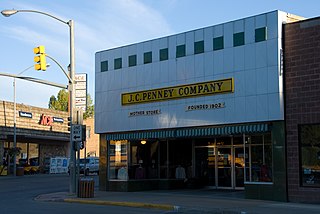
The J. C. Penney Historic District is a historic district in Kemmerer, Wyoming encompassing several properties associated with James Cash Penney (1875-1971). The district includes the Golden Rule Store, the first in what became the J. C. Penney department store chain, and Penney's home during the store's early years. The district was declared a National Historic Landmark District in 1978, for Penney's role in creating one of the first national department store chains.
Freemans is a British online clothing retailer headquartered in Bradford, England. Freemans offers a range of products, predominantly clothing, footwear and homewares.
Omnichannel is a neologism describing a business strategy. According to Frost & Sullivan, omnichannel is defined as "seamless and effortless, high-quality customer experiences that occur within and between contact channels".

The history of retail encompasses the sale of goods and services to consumers across all cultures and time periods from ancient history to the present.The first form of commerce was bargaining between early human civilizations. Beginning with Middle Eastern towns in the 7th millennium BCE, retail markets emerged when civilizations created money to allow commerce more easily. Open-air markets were created by numerous ancient Middle Eastern and European civilizations to enable merchants and other producers to sell goods to consumers. The earliest known permanent retail centers, the forums, were created in ancient Rome. Similar shopping centers are thought to have been created in China, but this information has been lost. Chinese retail was extensive by the first millennium BCE, and this included branding and packaging.
